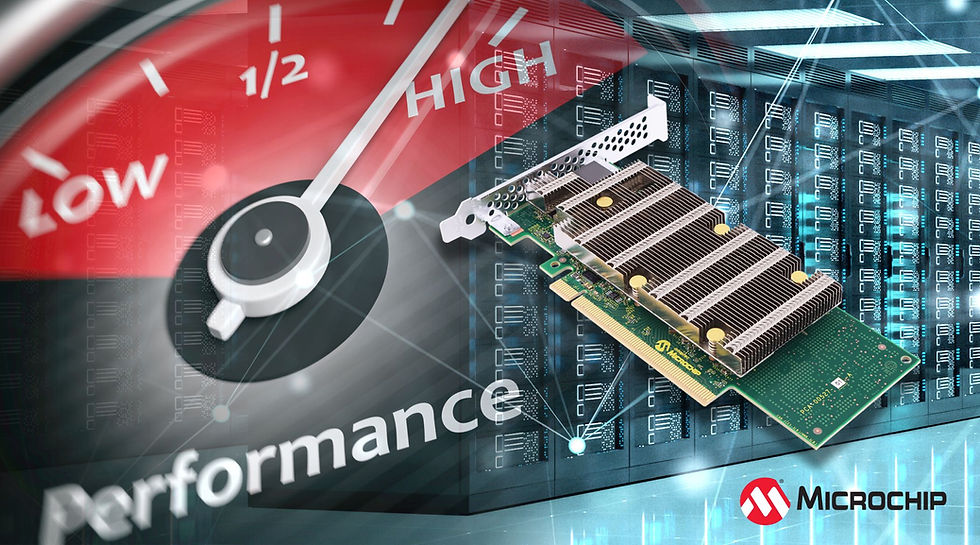Smart Analog Features of the PIC18-Q71 Family
- Marketing Artimar
- 2 de mai. de 2023
- 3 min de leitura
The PIC18-Q71 family of microcontrollers (MCUs) provides integrated analog peripherals for mixed-signal and analog applications.

PIC18-Q71 Product Family Overview
Traditionally, MCUs are primarily digital devices, with only basic analog capabilities. In other words, anything more advanced than basic measurements with an Analog-to-Digital Converter (ADC) would be implemented using discrete parts elsewhere in the design. However, this doesn't always have to be the case. The PIC18-Q71 family of MCUs pairs a high-performance PIC18 Central Processing Unit (CPU) core with integrated analog Core Independent Peripherals (CIPs) for mixed-signal and analog applications.
This family contains:
An Analog Peripheral Manager (APM)
A 12-bit Differential ADC with Computation and Context
A 10-bit Digital-to-Analog Converter (DAC)
Two 8-bit DACs
Two integrated Operational Amplifiers (OPAMPs) with Internal Resistor Ladders
A Fixed Voltage Reference (FVR)
Two Analog Comparators (CMPs)
A Zero-Cross Detect (ZCD)
A Temperature Indicator (TEMP)
These analog peripherals are in addition to the wide array of on-chip digital peripherals, like the 16-bit Pulse Width Modulator (PWM), Universal Timer (UTMR) and Cyclic Redundancy Check (CRC) with Memory Scanner.
With these analog peripherals, designs can be reduced in size, part count and power consumption. Notably, this is the first MCU family to contain an Analog Peripheral Manager (APM)—a special timer that can turn ON and OFF analog peripherals independently of the CPU. This can save a substantial amount of power in designs where continuous sampling is not required.
Another peripheral on-board is a 12-bit Differential ADC with Computation and Context. This peripheral differs from a normal ADC by including computation and context switching features. The computation features allow the ADC to perform multi-sampling operations and simple math operations internally, without using the CPU. Computation is commonly used to automate averaging or to enhance the resolution of the ADC through oversampling. The context switching feature in this peripheral allows the ADC to change settings automatically without CPU intervention. Inside of the ADC, four contexts are provided, with each having its own distinct set of settings. Each context can be enabled or disabled for design flexibility.
The PIC18-Q71 family also contains three separate DACs—a 10-bit and two 8-bit. The higher resolution 10-bit DAC provides more precision than the 8-bit DACs. This is especially important when pairing a DAC an analog comparator for threshold/setpoint monitoring of an analog signal.
The last peripheral in this blog post are the OPAMPs. These are discrete operational amplifiers built into the die of the microcontroller. An internal resistor ladder is provided with each OPAMP to set the gain or (less commonly) to generate a bias voltage without using a DAC. The OPAMP can be used with the other peripherals on the microcontroller, including the APM, CMP, ADC with Computation and Context and DACs.
Through these interconnections, more sophisticated applications can be created. For instance, let’s create a hypothetical low power temperature monitor that periodically samples a Resistance Temperature Detector (RTD), a special resistor that (almost) linearly changes resistance with temperature. One of the OPAMPs and DACs on the microcontroller is used to create a constant-current bias source for the RTD, while the ADC with Computation and Context measures the differential voltage across the resistor.
Figure 1 – RTD Measurement Circuit

Then, the APM is configured to periodically:
Enable the analog circuits (bias current + analog side ADC)
Wait for the analog circuits to stabilize
Enable the ADC sampling system (digital side of the ADC)
Wait enough time for the ADC to start and finish its conversion
Shutdown the peripherals to save power
This can save a substantial amount of power, as shown in the simplified diagram below.
Figure 2 – Simplified example of power consumption

The integrated analog features on the PIC18-Q71 family of microcontrollers enhance designs by reducing design area, part count and power consumption. For more information about the PIC18-Q71 family, please visit the family page to learn more.
Robert Perkel, Mar 28, 2023
Tags/Keywords: Industrial and IoT




Comentários